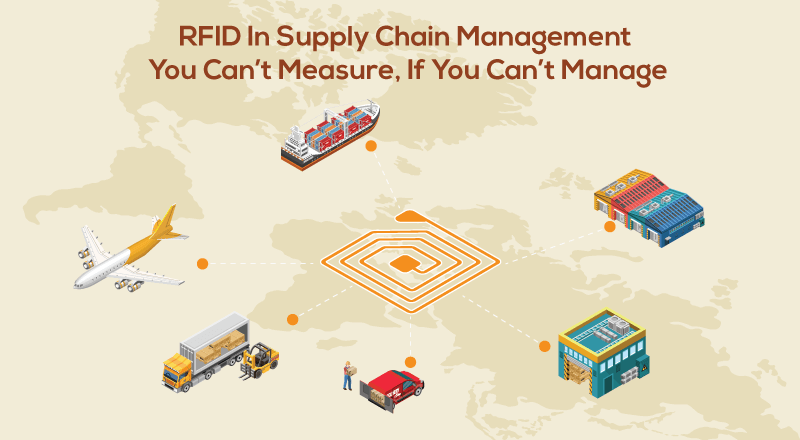RFID In Supply Chain Management: Implement Intelligence At The Next Level

#DoYouKnow: The products that are available in your favorite retail store go through quite a long journey?
Yes, any physical goods that are purchased have to go through supply chain process (from manufacturer to supplier to retailer and finally to the consumer) to produce, transport, and distribute products to the far-reaching corners.
What Is The Supply Chain Process?
In a simple manner, a supply chain is a flow of materials, information, money, and services from raw material suppliers through factories and warehouses to the end customers.
The term supply chain comes from the concept of how partnering organizations are linked together.
There is no doubt that supply chain management is an integral part of the e-commerce business. It provides quick and effortless shopping experience; instead of traveling to the stores, standing in the long queues to pay the bill, customers can comfortably purchase the products at the tip of fingers and get deliver the products at doorstep.
The reason behind this comfort is supply chain management. E-commerce, M-commerce business is completely dependent on SCM
When a customer purchases from the online stores, they look for quick delivery in minimum time. And if the logistic department fails to deliver on-time, the customer may never use that particular store.
So, in order to provide a great user experience, the supply chain needs to track every operation.
How Supply Chain can Streamline the Process?
Way back before decades, the SCM system used a barcode system to scan the data and in some supply chains, professionals use to enter the data manually.
Both resulted in a tedious, slow, and error-prone process.
Due to this, the system inventory didn’t match physical inventory and ultimately resulted in inconvenience.
The companies realized that manual scanning of barcodes of large volumes of item was becoming bottleneck and source of errors. Absence of real-time data leads to poor visibility which slowed down the decision making the process.
To stay at the top of the trends in the ever-growing complexity, companies needed innovative technology like RFID (Radio Frequency Identification Device) in supply chain management to identify the issues and streamline the operations.
RFID technology possesses the capabilities to fully automate the product identification in the supply chain process.
In fact, as per statista,
In 2020, the global market for RFID tags is projected to be sized at around 24.5 billion U.S. dollars.
But what actually RFID technology is? Let’s understand
What Is RFID Technology?
RFID is an acronym of Radio Frequency Identification Device. Basically, it’s a data collection technology that uses wireless signals to collect data from tags (tags- it is attached to object).
Through the radio communication between the tag and the RFID reader, this technology automatically identifies the object such as asset, inventory, people, etc.
The most important advantage of RFID is that it can scan more than one object at a time, unlike barcode which saves loads of time and energy.
For instance: to scan multiple objects in the warehouse, you just have to place all the objects near an RFID reader without worrying about its proper positioning.
Radiofrequency technology has come far from its roots and has passed through various phases from being not so popular to being widely accepted in most of the industries.
Let’s see how it has evolved.
Evolution of RFID
| Year |
|
| 1945 |
World War 2: The British tracked and identified the aircraft making the first RFID system |
| 1973 |
First RFID Tag: Mario W. Cardullo received the first US patent for an active RFID tag |
| 1990 |
The first Ultra High-Frequency Reader was invented with a 20-ft read range and faster data transfer |
| 2004 |
Walmart spent 50 million USD on RFID initiative |
| 2020 |
The RFID market is projected to reach 24.5 billion USD |
How does RFID work?
RFID readers consist of three components:
- RFID tags or smart labels
- RFID readers
- Antenna
Let’s see how the data is processed:-
- Data is stored within the RFID tag’s microchip that is connected to an antenna
- The tag chip contains a memory which stores the product’s electronic product code and other variable information
- The RFID reader is a network-connected device with an antenna that reads and tracks the information from RFID tags.
- Information collected from the tags is then transferred through a computer system, where the data can be stored in a database and analyzed later.
RFID is used in most of the industries but it is the heart of the supply chain management process.
So, how does it help in the supply chain management process?
Why RFID Is Must Have For Supply Chain Management Process?
To optimize the supply chain process, it needs accurate identification and tracking of goods as well as knowledge about what inventory a company have, where it is, how much it has and in what condition. And to solve this purpose,
Let’s see how RFID can help:-
- Product Forecasting and Management
Demand planning depends on historical sales and transaction data; it helps to create reliable forecasts. But Inventory forecasting becomes difficult if there is no timely and real-time data.
RFID can produce accurate and real-time information of work-in-progress, in-transit, and finished goods. Timely data about the market demand leads to accurate forecast, better inventory visibility and can have an immediate impact on top-line revenue by retaining the lost sales.
- Improved Inventory and Order Management
It is generally difficult to get clear visibility of what specific raw materials have arrived, availability of right materials, tracking of work in process, dispatching the right item to the right customer at the right time, etc.
RFID can help in improving these processes and help to reduce the inventory and order errors which results in minimizing production delays. Inventory accuracy and visibility can be drastically improved as RFID can track the delivered goods accurately in real-time, optimize the workflow and even reduce the excess inventory.
RFID readers deployed in the storage areas can automatically record the removal of an item and update the inventory records. Counting inventory can be processed quickly, as identification can be performed in bulk and accurately performed by RFID readers.
- Asset Tracking and Management
In many businesses, assets like pallets, trays, containers, equipment are often difficult to track.
But the RFID tag attached to the reusable assets can track them more efficiently. By placing the fixed RFID reader at strategic points, a company can automatically track the movement and location of the tagged asset, thus avoiding labor time.
RFID readers may also alert supervisors if there is any attempt to remove a tagged asset from an authorized area; this results in more security. Users can have full visibility of the inventory levels and locations, enabling them to locate quickly an item.
When items are collected for shipment, the tags can be read and automatically recorded in the system. As soon as the pallets are ready to dispatch, the handheld RFID reader can read the pallet tag and verifies the shipment content while providing real-time visibility in the system.
This result in time-savvy, cost-effective process, faster invoice settlement, minimizes human error and increases inventory accuracy and simplifies the receiving process.
Additional Benefits: How RFID is real promise in supply chain visibility
- Reduces the operating costs
- Can provide a high level of data integrity
- Doesn’t require the line of sight or direct contact to operate and can be read away from several meters
- Increased speed and agility in locating the products
- Less human resources are required to manage the products
- Reduction in the total cycle time
- Automatic records the input and output of the materials
- Increase efficiency and cut-down reworks
Of course, there are factors that hinder the implementation of RFID technology. Let’s see another side.
Concerns about implementing RFID
- RFID tag data can be read by anyone with a compatible reader which results in less security and privacy.
- Difficult to gain the commitment from top professionals and supply chain partners, because without them the project is sure to fail.
- The cost of implementing RFID into the supply chain is quite high, which may cause a big roadblock for the technology’s adoption.
- New technology may not available to all the suppliers.
Though there’re few obstacles in implementing RFI but seeing at its features and benefits, RFID can be the competitive edge to give more sustainability in the business.
Is RFID the way for the future?
The future belongs to the solution which is flexible, innovative, and affordable as well as provides enhanced customer service.
However, RFID is surely the perfect match for the futuristic solution.
RFID is one of the most promising, rapidly evolving and anticipated solution implemented in recent years. The demand and rise of e-commerce and m-commerce require better inventory and management and RFID is the one that has the potential to increase the ROI, serve customer faster; increases reliability & accuracy while at the same time improve the supply chain management process.
So, if you’re looking for the RFID based solution for your supply chain system, connect with us today. Being a leading logistics & supply chain software solutions company, SPEC INDIA strives to provide an innovative solution that can benefit the customers.
SPEC INDIA is your trusted partner for AI-driven software solutions, with proven expertise in digital transformation and innovative technology services. We deliver secure, reliable, and high-quality IT solutions to clients worldwide. As an ISO/IEC 27001:2022 certified company, we follow the highest standards for data security and quality. Our team applies proven project management methods, flexible engagement models, and modern infrastructure to deliver outstanding results. With skilled professionals and years of experience, we turn ideas into impactful solutions that drive business growth.




